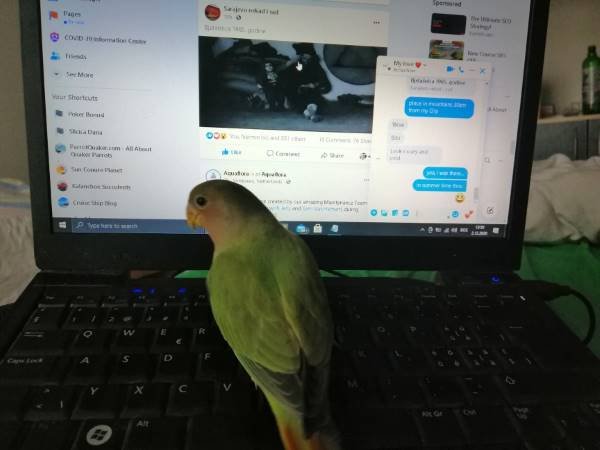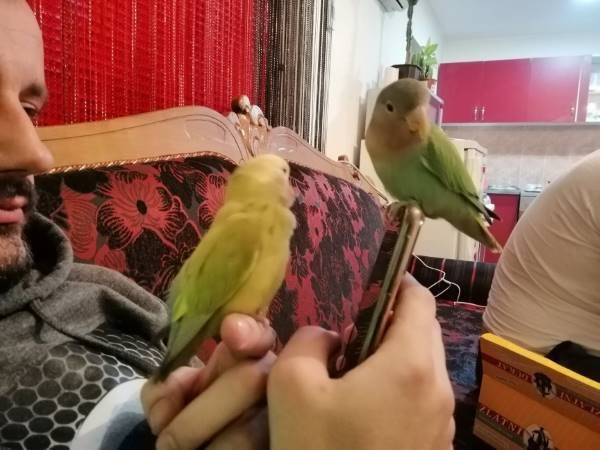There are many different color mutations of lovebirds due to both, natural mutations and selective breeding.
Some lovebird colors are rarer than others, and some are only found in certain parts of the world. In this article, we will explore some of the most popular lovebird colors and mutations.
There are 9 species of lovebirds – all with different color specifications. So let’s have a closer look at each lovebird species and their colors and some mutations.
Yellow-collared lovebird or masked lovebird
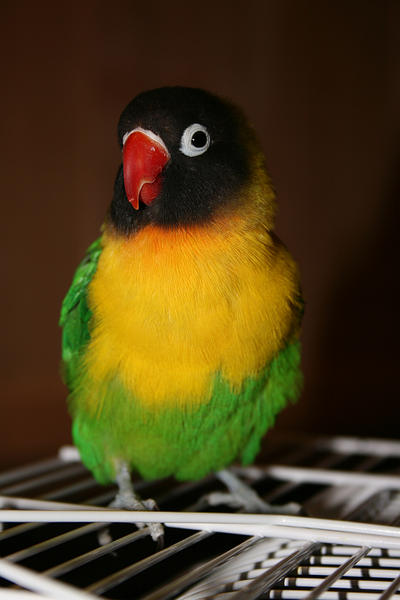
The masked lovebird is about 5.5 inches tall (14 cm) and comes originally from Northeastern Tanzania
Original colors:
Masked lovebirds are green and have a black head, with the exception of several yellow highlights. The color of their plumage is otherwise green.
Color Mutations:
Blue or yellow mutations have been seen, but they are quite rare. The blue mutation here actually means that the body is blue and not really their mask. The mask is still black, just as it is with the regular green color masked lovebird.

This blue mutation of the masked lovebird is actually the oldest known color mutation of lovebirds recorded.
This mutation has been observed in the wild. All other color mutations are the product of selective breeding. And there have been many ever since.
Some are:
Dilute slate, violett, lutrio, mauve and even albino.
How does the color mutation evolve?
Well, the blue and lutino mutations happen when some dominant color genes from the wild species have not been carried on are have been suppressed.
For example, in the blue color mutation, all yellow and red genes are missing. So all green colors are missing the yellow and red pigments and turn out – blue!
The lutino mutation is the same: the unique structure of the feathers that create the blue color is missing and so all yellow (except the in the face) will turn out orange.
Also, albino mutations are possible when a blue and a lutrino color lovebirds mix. In this case two of the basic colors are missing: blue, red, or yellow (which has partly green elements). So the birds appear (almost) white, although none Albino-colored mutations are actually completely white.
Another way to have mutation colors is dilution. This means that the colors mostly on the wings and face are lighter than normal.
This mutation originates from green color masked lovebirds that had been lighter by nature and therefore had a more yellow appearance. This mutation then was used to mainly breed lighter blue color lovebirds. This mutation is called today “Dilute Blue”.
Fischer’s lovebird

Fisher’s lovebirds are the same size as the masked lovebird, so also around 5.5 inches (14 cm) long.
Original colors:
The Fisher’s lovebird also comes originally from Tanzania and can be found in the south and southeast of Lake Victoria. Fisher’s Lovebirds are known to be very colorful.
They are mainly green with an orange upper head and body. The lower back and rump are mostly blue. It has a red break and white rings around the eyes.
The tip of their tale in turn is usually blue but also can be purple. And their legs are gray-blue.
Color Mutations:
There are many mutations possible since Fischer’s lovebird has strong genes. There are even many hybrids between the Masked Lovevid and the Fisher’s Lovebird. So the color variations seem endless.
Here are a few common color mutations of Fisher’s Lovebirds:
- Albino Fisher’s Lovebirds
- Pied Fisher’s Lovebirds
- Black or Dark Eyed White Fisher’s Lovebirds
- Dilute Blue Fisher’s Lovebirds
- Dilute Yellow Fisher’s Lovebirds
- Lutino Fisher’s Lovebirds
- Cinnamon Fisher’s Lovebirds
But there are also new mutations such as the Euwing and Opaline mutations.
The Opaline mutation extends the mask of the lovebird to almost cover the entire head to the shoulders. And the tip of the tale then will have the same color as the face.
The Euwing mutilation will come again in various types such as the Green Euwing mutation that produces a yellow gradient on the wings, and the Blue Euwing mutation that produces a gradient of gray colors.
This is very exciting to breeders since the Euwing mutation can be combined with many other mutations and really broadens out the color possibilities immense.

Lilian’s lovebird or Nyasa lovebird
The Lilian’s lovebird is a bit smaller than the previous two. They are only about 5 inches long (13 cm). They are very rare and come originally from Zambia in central east Africa Mozambique, Tanzania, and Malawi.
Original colors:
The color is a bit similar to the Fisher’s lovebird, but the Nyasa Lovebird has a solid green rump. Also, the beak is a bit paler, the white ring around the eyes, and also the nape is more light-colored than the Fisher’s Lovebird.

Usually, they have an orange head and a solid red beak.
Color Mutations:
Real Lilian’s lovebird or Nyasa lovebird mutations are rare. Actually, there are only three color mutations known:
- The original wild green mutation
- The Lutino mutation
- The Dilute mutation
But there are many hybrid color variations since lovebirds interbreed readily. So it’s really hard to know whether a certain color is actually are legitimate color mutation or a hybrid color bird.

Black-cheeked lovebird
The Black-cheeked lovebird is, just like the Fisher’s lovebird about 5.5 inches long (14 cm) and comes from Zambia in Southeast Africa.
Original colors:
Black-cheeked lovebirds are mostly green and have cheeks that are brown to black colored (hence the name).
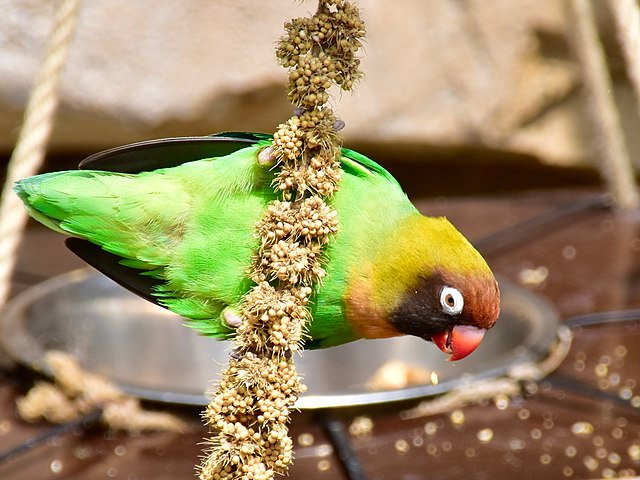
On their forehead, they are brown to red-colored and have white rings around their eyes.
Color Mutations:
It’s interesting that the Black-cheeked lovebirds actually have no confirmed true color mutations.
So be careful if you come across a “Black-cheeked color mutation”. They are not really mutations, but rather hybrid birds, mostly from Masked Lovebirds and Black-cheeked lovebirds.
Lately, there were some reports of an observed “real” blue mutation. But this is not yet confirmed and therefore most like not true.
Peach-faced lovebird or rosy-faced lovebird

The Peach-faced lovebird is with 6ich inches in length (15cm) bigger than the other lovebirds. Also, these birds come from Southeast Afrikan countries such as Botswana, Angola, Namibia, and South Africa. But lately, they are also seen in Phoenix, Arizona, USA.
Original colors:
This lovebird also is mostly green with a blue back and an orange face. But there are two Dominant colors, that all peach-faced Lovebirds belong to:
- Wild green variant (or green series)
- Blue variant (with two subcategories)
- Aqua (or Dutch Blue or Seagreen variant)
- Turquoise (or White-faced blue variant)
Color Mutations:
There are almost endless variations, mutations, and also combinations possible with these birds. Some estimate that there exist almost 100,000 different variations and combinations of the Peach-faced lovebird.

Good to know:
There is a big difference between a “combination” and a “mutation”.
A mutation is a genetic change and comes from a pairing of two pure main species, whereas a combination always means a pairing of pure mutations.
Some main color mutations are:
- Dutch Blue, White-Faced Blue or Aqua- or Seagreen
- Orange faced
- Fallow (with red eyes and purple rump)
- America Yellow or Cherryhead (with a number of dilute colors)
- Yellow dilute (more white-colored than yellow)
- Blue dilute (more light-blue colored)
- Japanese Yellow ( or imperial golden cherry)
- Australian Recessive Pied (or card-eyed clear)
As mentioned there are many combinations of these mutations:
- American White (silver)
- Cremino
- Cinnamons
- Lacewing
- Gray wings
- Whitefaced
- Orange faced
- And many more….
It’s interesting though, that there is no Albono mutation with the Peach-faced lovebird. At least there has not been one discovered yet.
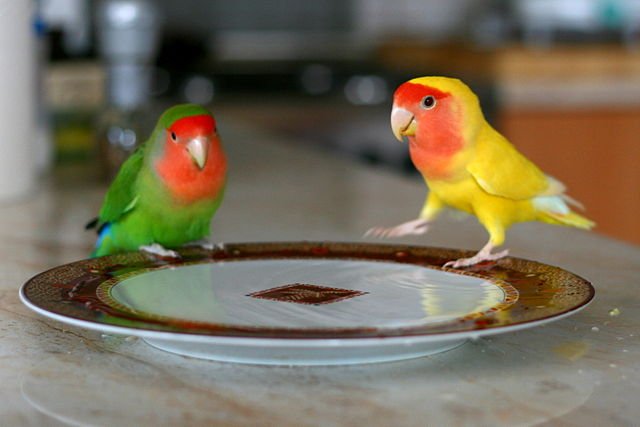
Black-winged lovebird or Abyssinian lovebird
The Black-winged lovebird is among the largest lovebirds with about 6.5 inches in length (16.5 cm) long. They are mostly from East Africa, Eritrea, or Ethiopia.
Original colors:
The Black-winged lovebird is also mostly green but has some black feathers on its wings and a red break.
The male can be clearly distinguished by the crown on its forehead, which has a beautiful bright red color.
This lovebird is very rare and not often found in captivity.
Color Mutations:
Although the Black-winged lovebirds is not really common in captivity there have been some remarkable color mutations.
Those are:
- Wild Green
- Dark Green
- Olive Green ( this is the most expensive of all mutations of this lovebird)
In addition, are some other very rare color variations:
- Cinnamon
- Lutino
- Yellow
Red-headed lovebird or red-faced lovebird
The Red-headed lovebird is about 6 inches long (15 cm) and comes from central and western African countries.
Original colors:
Most Red-headed lovebirds’ plumage is green, except for the red and orange areas on their face, without any white ring around their eyes.

The feathers of her wingtips are black while the abdomen and underskirts are yellowish or light green in color. The underside of their wings usually is light green.
Color Mutations:
It’s very hard to bread these lovebirds in captivity. Therefore little is known about the possibility to get color mutations.
However, a subspecies of the Red-headed lovebird, the red-headed Ugandae lovebird has a slightly different color with a less bluish tail.
Grey-headed lovebird or Madagascar lovebird
The Grey-Headed lovebird is among the smallest lovebirds and is only about 5 inches long (13 cm). As the name indicates, these birds are native in Madagascar, an island on the east side of Africa.
Original colors:
The Madagascar lovebird is entirely green, with darker green wings. The male differentiates in color from the female as it has a light grey upper body, whereas the female has a lighter green chest.

They are also very hard to breed and very rare to find in captivity. Very few breeders were able to keep more than 2 generations of Madagascar lovebird alive.
Color Mutations:
It might be surprising, but actually, no color mutations are now for the lovebird.
Black-collared lovebird or Swindern’s lovebird
The Balck-collared lovebird is also very small with only 4-5 inches in length (13.5 cm) and is originally from Equatorial Africa.
Also, this lovebird is very difficult to breed and therefore not seen as pets or in captivity in general.
Original colors:
The Black-collared lovebird is mostly green, with a yellow chest and a gray dark neck and face with white rings around its eyes.
Color Mutations:
Although very little is known about the possibility to breed them and creating color mutations, there are two subspecies of the Swindern’s lovebird that have slightly different color patterns:
- Agapornis zenkeri. These birds are native to Cameroon and the Congo. These lovebirds have a brown to red coloring from their breast to their neck.
- Agapornis emini. These birds are also to be found in the Congo, but also in Uganda. They are similar to the coloring of Agapornis zenkeri, but have lighter brown and red colors.
Really, there are so many different mutations and combinations that it’s hard to tell how many in total exist.
But for sure more beautiful lovebird mutations and colors will be observed in the future.


